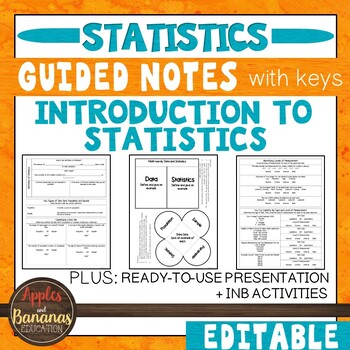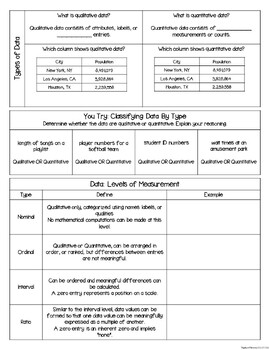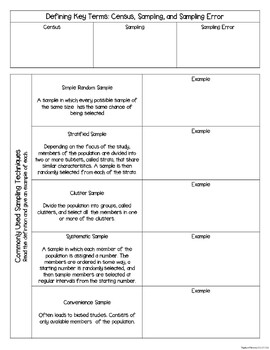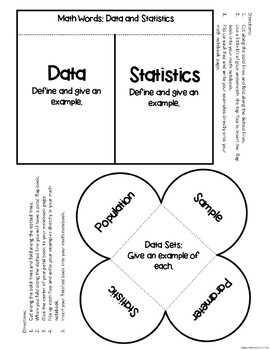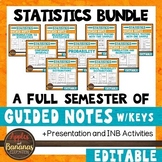Introduction to Statistics - Guided Notes, Presentation, and INB Activities
- Zip
Also included in
- Price $198.77Original Price $283.95Save $85.18
- These Statistics products are flexible, editable, and can be used for in-person or distance learning. Each unit contains guided notes embedded with student practice problems (keys included), foldable activities, and a PowerPoint presentation for focused instruction. Choose what works best for your cPrice $68.00Original Price $85.25Save $17.25
Description
This Introduction to Statistics product is flexible, editable, and can be used for in-person or distance learning. Take the time and stress out of creating your own guided notes and presentations. There are many ways to use this engaging bundle. It includes guided notes embedded with student practice problems (keys included), foldable activities, and a PowerPoint presentation for focused instruction. Choose what works best for your class/student and modify to make the content fit your needs. Notes are designed to clearly present the topics and reach all types of learners.
The zip file includes BOTH editable, plain-font resources and ready-to-print, non-editable PDFs. Suggested use guides are included. These materials may be placed on an LMS for distance learning!
Interactive Math Notebook FORMAT – Includes 2 parts: guided notes and foldable activities. Piece the components together and students can create their own “math textbook” in a math journal.
- The guided notes activities contain sample teacher answer keys. Example problems are solved on the sample teacher answer keys, but you can have your students use them over and over again with problems from your own curriculum. We have also added "You Try" activities in order to allow students to complete independent practice in between note-taking activities.
- The interactive notebook foldable activities include descriptions for use. We have not included specific examples for the interactive notebook activities. We like to give them to students for review so that they can show what they have learned and personalize their notes.
Presentation – This product contains a plain-font, no frills, PowerPoint presentation that you can use to present content to students whether you are in-person or remote. Modify the editable presentation to best fit your needs.
This bundle also contains a description of how to use the materials included and the suggested groupings for presenting the notes and interactive notebook activities with your students.
This product is perfect to use with any textbook or e-book curriculum and great for engaging all types of learners, including those with special needs.
Guided Note Sheets with Sample Teacher Keys for the following topics:
- Definition of Statistics
- Two Types of Data Sets
- Classifying a Data Set
- Identifying Data Sets
- Your Turn: Identifying Data Sets
- Parameter vs Statistic
- Distinguishing Between a Parameter and a Statistic
- Your Turn: Parameter or Sample Statistic?
- Branches of Statistics
- You Try: Identifying Descriptive and Inferential Statistics
- Types of Data
- You Try: Classifying Data By Type
- Data: Levels of Measurement
- Identifying Levels of Measurement
- You Try: Classifying By Type and Level of Measurement
- Guidelines for Designing a Statistical Study
- Methods of Data Collection
- You Try: Deciding on the Method of Data Collection
- Deciding on the Method of Data Collection
- Factors that Can Ruin Experimental Results
- You Try: Identifying Factors Effecting Results
- Techniques that Can Be Used to Get Unbiased Results
- You Try: Which Technique Is Being Described
- Validity Of An Experiment: Sample Size and Replication
- You Try: Sample Size And Replication
- Defining Key Terms: Census, Sampling, Sampling Error
- Commonly Used Sampling Techniques
- You Try: Determining Sampling Methods
Plus corresponding Interactive Math Notebook Foldable Activities and Presentation.
Related Products:
**Full-year Curriculum Packs**
Algebra 1, Geometry, Algebra 2 Curriculum Pack MEGA BUNDLE
Algebra 1 Curriculum Pack BUNDLE
Geometry Curriculum Pack BUNDLE
Algebra 2 Curriculum Pack BUNDLE
Scaffolded Notes/Interactive Notebook Bundles
Pre-Calculus Add on for Algebra 2 INB Bundle
High School Math Interactive Notebook Bundle (Algebra 1, Geometry, Algebra 2)
Student Practice Pages Bundles
Algebra 1 Student Practice Pages Bundle
Geometry Student Practice Pages Bundle
Algebra 2 Student Practice Pages Bundle
High School Math Student Practice Pages Bundle (Algebra 1, Geometry, Algebra 2)
Assessment Bundles
High School Math Assessment Bundle (Algebra 1, Geometry, Algebra 2)
**If you like what you see, please click on the "Follow Me" star to learn about new products, sales, and more!

